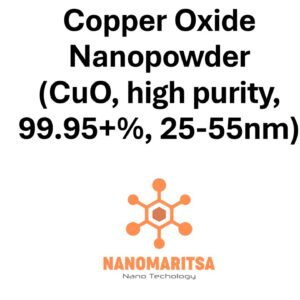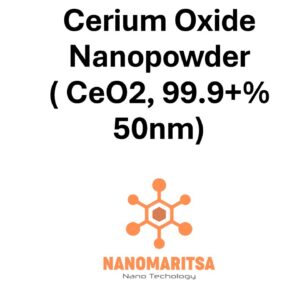Manganese oxide nanopowder (Mn₂O₃, 99+%, 30 nm) is a high-purity material with unique physical and chemical properties that make it suitable for various applications in energy storage, catalysis, environmental remediation, and materials science. With a particle size of 30 nm and a purity of over 99%, this manganese oxide nanopowder offers enhanced reactivity, surface area, and performance compared to its bulk counterparts.
Composition and Structure
Mn₂O₃ (Manganese Oxide):
Manganese(III) oxide, or Mn₂O₃, is an inorganic compound formed by the oxidation of manganese. It is one of the many oxide forms of manganese, characterized by its high reactivity and catalytic properties. Mn₂O₃ can exist in several crystalline forms, but the nanopowder typically consists of a more amorphous or semi-amorphous structure at the nanoscale, which enhances its surface area and reactivity.
Purity (99+%):
The high purity of 99+% ensures that the nanopowder is free from most contaminants, making it highly suitable for sensitive applications in electronics, energy storage, and catalysis, where material consistency is critical.
Particle Size (30 nm):
With a particle size of 30 nm, this manganese oxide nanopowder has a large surface area relative to its volume. The fine particles enhance the material’s reactivity and efficiency in various applications, offering superior performance compared to larger particles of the same material.
Properties
- High Surface Area and Reactivity:
The nanopowder form of manganese oxide significantly increases its surface area, enhancing its reactivity in chemical processes. This makes it highly effective in catalytic applications, energy storage, and environmental remediation. - Thermal Stability:
Mn₂O₃ exhibits good thermal stability and can withstand relatively high temperatures before undergoing decomposition or phase transitions. This makes it suitable for use in high-temperature processes and applications. - Electrical Conductivity:
Manganese oxide has semiconducting properties, and its nanopowder form can exhibit enhanced electrical conductivity. This makes it valuable in energy storage devices like supercapacitors and batteries. - Catalytic Properties:
Manganese oxide is an effective catalyst in a variety of reactions, particularly in oxidation processes. Its catalytic efficiency increases with the reduction in particle size, making nanopowder an ideal choice for industrial catalytic applications. - Magnetic Properties:
Manganese oxide can exhibit magnetic properties under certain conditions, making it useful in magnetic and electronic applications. The nanoscale form can enhance these properties, leading to more efficient and effective materials.
Applications
1. Energy Storage and Batteries:
Supercapacitors:
Manganese oxide nanopowder is commonly used in supercapacitors due to its excellent electrochemical properties. It enhances the capacitance and cycling stability of supercapacitor electrodes, contributing to improved energy storage and faster discharge rates.
Lithium-Ion Batteries:
Mn₂O₃ is explored as an electrode material in lithium-ion batteries, where its ability to reversibly absorb and release lithium ions improves the battery’s charge-discharge efficiency. The nanopowder form increases surface area, improving performance.
Batteries for Electric Vehicles (EVs):
Manganese oxide is also used in rechargeable battery technologies for electric vehicles, offering a lower-cost and environmentally friendly alternative to other materials like cobalt.
2. Catalysis and Chemical Reactions:
Oxidation Reactions:
Manganese oxide nanopowder is widely used in oxidation reactions, such as the oxidation of carbon monoxide to carbon dioxide or the oxidation of hydrocarbons. The material’s high reactivity makes it an excellent catalyst for these processes.
Environmental Catalysis:
Mn₂O₃ is used in environmental catalytic processes, particularly in the reduction of harmful emissions from industrial sources. It helps in the removal of nitrogen oxides (NOx) and other pollutants from exhaust gases.
Fischer-Tropsch Synthesis:
In the production of synthetic fuels from syngas, manganese oxide is used as a catalyst to facilitate the conversion of carbon monoxide and hydrogen into liquid hydrocarbons. The nanopowder form improves reaction efficiency and yields.
3. Environmental Applications:
Water Treatment:
Manganese oxide nanopowder is effective in water treatment processes, particularly in the removal of heavy metals and organic pollutants. Its high surface area allows it to adsorb and remove contaminants from water, improving water quality.
Pollution Control:
Mn₂O₃ is used to treat industrial waste and to catalyze the degradation of pollutants, such as volatile organic compounds (VOCs) and other harmful substances in air and water.
CO₂ Sequestration:
Manganese oxide is being explored as part of carbon capture and sequestration technologies, where it can absorb and convert CO₂ into less harmful substances, helping to reduce greenhouse gas emissions.
4. Materials Science and Nanotechnology:
Composite Materials:
Manganese oxide nanopowder is used in the development of composite materials that exhibit enhanced mechanical, electrical, and thermal properties. These composites are widely used in industries such as electronics, aerospace, and automotive.
Nanostructured Materials:
Mn₂O₃ nanopowder is also used in the synthesis of nanostructured materials that have applications in sensors, catalysts, and energy storage devices. The fine particles facilitate the creation of materials with controlled properties and improved performance.
5. Sensors and Detection:
Gas Sensors:
Manganese oxide nanopowder is employed in the development of gas sensors, where it can detect various gases by observing changes in electrical conductivity. This makes it useful for environmental monitoring and industrial safety.
Magnetic Sensors:
Due to its potential magnetic properties, Mn₂O₃ nanopowder can be used in magnetic sensors, contributing to more sensitive and efficient detection systems in a variety of applications.
Safety and Handling
Health Considerations:
Manganese oxide is generally considered to be safe, but as with all nanopowders, care should be taken to avoid inhalation of dust particles, as they may pose respiratory risks. Appropriate safety measures, such as wearing masks, gloves, and eye protection, should be used during handling.
Environmental Impact:
Manganese oxide nanopowder is not highly toxic to the environment and is generally considered to be biodegradable. However, like other nanomaterials, it should be handled with care to prevent unintended environmental release. Proper disposal methods should be followed to avoid contamination.
Summary
Manganese oxide nanopowder (Mn₂O₃, 99+%, 30 nm) is a highly versatile material with a wide range of applications in energy storage, catalysis, environmental protection, and materials science. Its high surface area, catalytic properties, and enhanced reactivity make it ideal for use in supercapacitors, batteries, and catalytic processes. By harnessing the unique properties of manganese oxide nanoparticles, significant advancements can be made in various technological fields, contributing to improved performance and efficiency in industrial and environmental applications.
| Measurement (gr) | 100 grams, 500 grams, 1000 grams |
|---|






